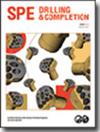Risk-Controlled Wellbore Stability Criterion Based on a Machine-Learning-Assisted Finite-Element Model
IF 1.2
4区 工程技术
Q3 ENGINEERING, PETROLEUM
引用次数: 2
Abstract
In certain drilling scenarios, the mud weight required to completely prevent wellbore enlargement can be impractically high. In such cases, what is known as risk-controlled wellbore stability criterion is introduced. This criterion allows for a certain and manageable level of wellbore enlargements to take place. Conventionally, the allowable level of wellbore enlargements in this type of model has always been based on the magnitude of the breakout angle. However, wellbore enlargements, as seen in caliper and image logs, can be highly irregular in terms of their distribution around the wellbore. This means that risk controlling wellbore stability through the breakout angle parameter can be insufficient. Instead, the total volume of cavings is introduced as the risk-control parameter. Unlike the breakout angle, the total volume of cavings can be coupled with a suitable hydraulics model to determine the threshold of manageable enlargement. The volume of cavings is determined using a machine-learning (ML)-assisted 3D elastoplastic finite-element model (FEM). The model implementation is first validated through experimental data. Next, a full data set from offset wells is used to populate and train the model. The trained model is then used to produce estimations of risk-controlled stability mud weights for different drilling scenarios. The model results are compared against those produced by conventional methods. Finally, both the FEM-ML model and the conventional method's results are compared against the drilling experience of the offset wells. The results illustrate how this methodology provides a more comprehensive and new solution to risk controlling wellbore stability.基于机器学习辅助有限元模型的风险控制井筒稳定性判据
在某些钻井情况下,完全防止井筒扩大所需的泥浆比重可能高得不切实际。在这种情况下,引入了所谓的风险控制井眼稳定性准则。该标准允许井筒扩大达到一定的可控水平。通常,在这种模型中,允许的井筒放大水平总是基于破裂角的大小。然而,从井径仪和成像测井中可以看出,井眼放大在井筒周围的分布是非常不规则的。这意味着通过破漏角参数控制井筒稳定性的风险可能是不够的。引入垮落体总量作为风险控制参数。与破裂角不同,崩落体的总体积可以与合适的水力学模型相结合,以确定可控制的扩大阈值。利用机器学习(ML)辅助的三维弹塑性有限元模型(FEM)确定崩落体的体积。首先通过实验数据验证了模型的实现。接下来,使用邻井的完整数据集来填充和训练模型。然后使用训练好的模型对不同钻井场景下的风险控制稳定性泥浆比重进行估计。将模型结果与常规方法的结果进行了比较。最后,将FEM-ML模型和常规方法的结果与邻井的钻井经验进行了比较。结果表明,该方法为井眼稳定性风险控制提供了更全面、更新颖的解决方案。
本文章由计算机程序翻译,如有差异,请以英文原文为准。
求助全文
约1分钟内获得全文
求助全文
来源期刊

SPE Drilling & Completion
工程技术-工程:石油
CiteScore
4.20
自引率
7.10%
发文量
29
审稿时长
6-12 weeks
期刊介绍:
Covers horizontal and directional drilling, drilling fluids, bit technology, sand control, perforating, cementing, well control, completions and drilling operations.
 求助内容:
求助内容: 应助结果提醒方式:
应助结果提醒方式:


